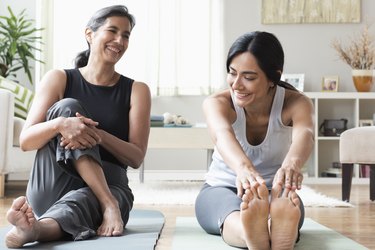
Any time is a good time to engage in habits that can help you feel your best as you age. But starting the day off in a way that does right by your body (and your mind) can be especially worthwhile.
"In my care of patients, I see a direct correlation between good lifestyle habits and overall health," says Jennifer Atmore, MD, a geriatric medicine physician at Texas Health Presbyterian Allen and Texas Health Physicians Group.
Video of the Day
Video of the Day
And when you engage in those habits first thing, you may be more likely to keep up the good work later on. "Starting the day with small but important accomplishments tends to set the tone for a successful day," Dr. Atmore says.
Don't worry, we're not talking about jumping out of bed to run a marathon or guzzle a green smoothie. These six strategies are easy and enjoyable, while still managing to pack a big stay-healthy punch.
1. Have a Cup of Coffee
Sure, it'll perk you up. But even more important? It's linked to a longer life.
Coffee is rich in antioxidant compounds, and moderate consumption (think: three to four cups daily) is tied to a lower risk of heart disease, type 2 diabetes, depression, obesity, cancer and some neurodegenerative diseases, per a May-June 2018 review in Progress in Cardiovascular Diseases.
You'll reap the biggest health benefits from plain black coffee. "It contains all the healthy polyphenols and antioxidants without any of the inflammatory compounds from too much sugar or creamy additives," says Dana Ellis Hunnes, PhD, MPH, RD, senior dietitian at UCLA Medical Center and author of Recipe for Survival.
But if the taste is too strong, a teaspoon of sugar or a splash of nondairy milk is also OK, she says.
2. Eat a Savory Breakfast
Opt for eggs and whole-grain toast, scrambled tofu with veggies or savory oatmeal over cold cereal or a pastry. Sugary meals tend to promote inflammation and encourage the body to store more fat, Hunnes points out.
And over time, those effects can add up: Adults who get more than 20 percent of their daily calories from sugar have a 30 percent higher mortality risk compared to those who keep their sugar intake between 7.5 and 10 percent of their total calories, found a February 2019 study in the The American Journal of Clinical Nutrition.
Savory breakfasts often have the added benefit of being higher in protein too. (Two scrambled eggs deliver 12 grams, while a blueberry muffin has just 6 grams, for instance.)
Nearly half of older adults don't get enough protein, per a February 2019 report in the Journal of Nutrition, Health and Aging, which can hasten the muscle, bone and strength losses that occur naturally with age.
But: "Protein-rich meals can help reduce how much muscle we lose," Hunnes says.
3. Read While You Eat
Peruse the paper or dig into a new novel as you nosh on your first meal of the day.
"It is recommended to try to engage the brain for maximum function," Dr. Atmore says. "Reading is an easy task one can practice to promote mental stimulation on a daily basis."
Indeed, adults who read more frequently — at least once a week — were less likely to experience cognitive decline 14 years later, found a January 2021 International Psychogeriatrics study.
And the benefits may go beyond brain health: Regular readers were found to have a 20 percent lower risk of dying over the course of 12 years regardless of race, education, health, wealth, marital status or depression, per a September 2016 Social Science & Medicine study.
4. Stand on One Leg While Brushing Your Teeth
Natural declines in musculoskeletal health, sensory systems and cognition all contribute to worsening balance as we age. But finding ways to challenge your balance can help keep those skills in check, reducing the risk for falls and allowing you to be independent for longer, according to the National Institute on Aging.
"Standing on one leg will build leg strength and improve equilibrium and coordination," says Robert Herbst, a personal trainer and power lifter based in New York. (If you feel unsteady, try holding onto the counter with one hand to start.)
For the biggest benefits, make it a point to regularly practice more formal balance exercises too, like heel-to-toe walking or lunges, Herbst suggests. Toe raises work too!
5. Go for a Walk
It's no secret that regular exercise is one of the best things you can do to support your overall health. And physical activity only becomes more crucial with age.
"Staying active reinforces balance and brain health," says Dr. Atmore.
Reducing sedentary time can also protect your heart, help you maintain a healthy weight and support stable blood sugar levels, per April 2017 exercise guidelines for older adults by American Family Physician.
And many experts agree that brisk walking is one of the best ways to get moving. "It can achieve all the health benefits of more aggressive exercise but is easy to perform at any age or fitness level," Dr. Atmore says.
Aim for a 30-minute stroll at least five days a week, but if you can go longer, that's even better.
6. Cool Down With a Few Stretches
Flexibility exercises can keep your joints limber, making it easier to accomplish everyday tasks like reaching for high objects or getting dressed. And the best time to do them is after moderate aerobic or resistance activities, according to American Family Physician.
Certified personal trainer Jordan Hosbein, NASM-CPT, recommends a short series of full-body stretches (hold each for 10 to 20 seconds):
- Toe touches: Hang your torso forward with your arms extended toward the floor. Slowly reach toward your toes, resisting the urge to bounce or jerk.
- Grand rising stretch: Reach your hands up toward the ceiling, lengthening your arms, legs and back.
- Torso stretch: Extend your arms overhead and lean to the left until you feel a gentle stretch through your right side. Slowly come back to center and repeat on the other side.
- Shoulder stretch: Bring your right arm straight across your body, pulling it close to your chest with your left arm. Switch sides.
- Quadricep stretch: Holding onto a chair for stability, pull your right leg up behind you and grab it with your hand. You should feel a stretch in the front of your thigh. Switch sides.
- Calf stretch: Stand in a staggered stance with one foot behind you. Try to keep the heel of your rear foot on the ground while you lean forward slightly. Switch sides and repeat.
- Progress in Cardiovascular Diseases: "Coffee for Cardioprotection and Longevity"
- The American Journal of Clinical Nutrition: "Association between added sugar intake and mortality is nonlinear and dependent on sugar source in 2 Swedish population–based prospective cohorts"
- Journal of Nutrition, Health and Aging: "Low Dietary Protein Intakes and Associated Dietary Patterns and Functional Limitations in an Aging Population: A NHANES Analysis"
- International Psychogeriatrics: "Reading activity prevents long-term decline in cognitive function in older people: evidence from a 14-year longitudinal study"
- Social Science & Medicine: "A chapter a day: Association of book reading with longevity"
- National Institute on Aging: "Balance Problems and Disorders"
- American Family Physician: "Exercise Prescriptions in Older Adults"
Is this an emergency? If you are experiencing serious medical symptoms, please see the National Library of Medicine’s list of signs you need emergency medical attention or call 911.


